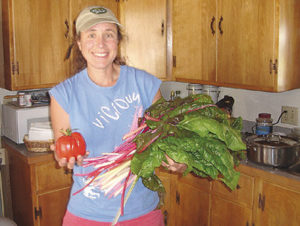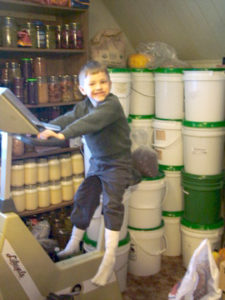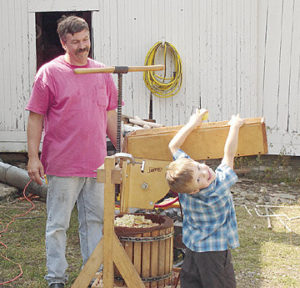 |
| Colette harvests big tomatoes, and abundance of chard, and much more to supply her family all year with fresh and preserved produce. Photo courtesy of the Thompson family. |
by Marada Cook
Hestia was a goddess of hearth and fire. Greek script lacks capital letters to distinguish names from objects, so Hestia meant literally the ‘hearth,’ the center of the home kitchen, and the keeper of the flame. A French scholar pointed out that while the ‘fire-power’ of Hermes represented money, currency and mobility, Hestia’s represented stability: Her stationary position transformed the products of the outside world into those of domestic content.
In a season that leaves ample time for contemplating the hearth and eating hot meals, it is still all too easy to overlook those who feed the home fires year round. As farmer/grandmother/cook Chris Colson of New Leaf Farm puts it, “There’s always that person, usually the ‘farm-mom,’ who feels guilty about being the last one out to the field, even when they’ve made sure everyone got enough to eat, and there’s something still for tomorrow.” This article pays homage to a family in snow-coated northern Maine, with the idea that variations on the theme of their work, replicated around the state, feed every part of our movement.
A robust ‘Pioneer Maid’ stands warmly in the center of the hundred-year-old farmhouse. Colette Thompson tells me to leave my shoes on as she adds another log to the Amish-built woodstove. A small, round table rests before a window that frames a snow covered garden and greenhouse; on the table are apples, a tray of butter, a few tea mugs. She is unsure where to start. I ask what smells so good.
“Oh, I made bread this morning. We’d been carving off the end of the same stale loaf for a few days, so I decided it was time.” The bread is honey-sweetened whole wheat with poppy, flax and sunflower seeds. She brings out two small dishes of flavored goat butter from the fridge. Colette sets it before me, and her husband Lee comes into the kitchen from the sunny front living room.
“When we moved here, we knew we could support ourselves if we were really proactive about it. The land was worn out potato fields.” Lee Thompson wrestles marble and granite into high-end countertops. He has to drive ‘downstate’ (as Aroostook County folk call the southern end of Maine) to do this, but when he’s in New Sweden, his efforts are purely on the home front.
“No one is going to be 100% self-sufficient,” he says, “and we wouldn’t want to be, but we cut our own firewood, put up our own food, keep our own meat. When you do that you’re not worried about the day everything could stop – if the oil ran out it would take a few days before we’d even hear about it.”
Colette laughs at this, because their neighbors – a few homes and a senior assisted living center – would certainly update them, but as far as food goes, an early hard frost has a more profound impact on her life than a national transportation failure.
“This fall the peppers in the greenhouse got zapped,” she says, going over to the freezer, “I felt like crying, you know, because I provide the meals for Kennith [their son] and Lee – and that’s my supermarket out there!” She pulls out a bag of whole frozen chilies. “But there’s always some way not to let things go to waste.”
 |
| Five-year-old Kenneth at play in the Thompson family pantry. Photo by Marada Cook. |
What Colette sums up with a wry smile is a whole year’s efforts to stock the pantry. We climb the steep, carpeted stairs to a back bedroom. Five-year-old Kennith darts through the door and hops on a stationary bicycle. His legs don’t reach the peddles from the seat, and one of the peddles hangs up on bags of walnuts and pecans on a shelf.
“This is it,” Colette says. In the 8 x 10 room are two dozen five-gallon food grade pails with grains, beans and dry goods. On the shelves lining two walls are five hundred jars – some pints, some quarts – of tomatoes, beans, applesauce, onions, beets, corn relish, pickles, fruit juice, cider, zucchini sauce, jam, fiddleheads and whole berries. Honey by the gallon sits in pails. There are two shelves of canned beef and pork from their own livestock. A chest freezer holds finer cuts and freezable produce. Hard cider fills a barrel.
 |
| Kennith and Lee work the apple cider press. Photo courtesy of the Thompson family. |
“Lee was into gardening and canning before we moved here,” Colette explains, “We just started to do more and more. His mother came from a farm. My mother came from a farm.” Colette is a nutrition counselor for seniors in Aroostook County and finds seniors are rarely surprised by her efforts. “They remember doing all these things we are learning again.” Without their mothers at hand, Colette and Lee swear by Carla Emery’s Encyclopedia of Country Living.
Just before the table is set, all earnest intentions meld with the reality of day-to-day life. At mid-afternoon Colette feeds Kennith and me goat cheese off an aged wheel, frozen seedless grapes from the neighbor’s vines, and apple-grape juice that left the family ‘a mess’ but was well worth the trouble. Kennith nibbles the small, hard apples on the table. Colette reminds him not to waste, to nibble only one at a time.
“I never know until it’s time to eat what we’re going to have for dinner,” Colette says. This takes me by surprise. What kind of hearth goddess doesn’t have a divine and long-term plan for each sumptuous meal? I’ve been wondering how one spends every daylight hour in the garden or farm fields and then lavishes upon the family feasts worthy of Little House on the Prairie or The Sojourner. It turns out Colette soaks her beans back in March.
 |
| Kennith is one with his cookie-making. Photo courtesy of the Thompson family. |
“I’m really into easy meals in the summer time. I bake more, make more complicated dishes in the winter, when the woodstove is going all the time, but I can 12 months of the year. When it’s maple sugar season, I bake quarts of beans on the same fire and can them for July. When the vegetables come in September, I make cold soups for August.” She grins at my consternation.
“So you don’t just put up food for the winter, then?”
“No, a lot of what I can and freeze actually gets eaten in the spring and summer.”
Colette adores her pressure canner, a $30 yard sale find when the Thompsons still lived in Harrison. She credits a Women in Agriculture (WAgN) tour to Gloria Varney’s Nezinscot Farm for inspiring her to make her own (delicious) aged goat cheeses. She keeps what she calls ‘The Cheat Book’ – a hardbound journal with yearly tallies of what got put up – and, as with green beans, what got left over. In 2001, when Kennith was born, the pages are blank. By 2003, when the couple moved to New Sweden, the tally marks spread across the page. By 2005, they are color-coded.
“This year, for the first time ever, I think we have more than enough food to see us all the way through to the next growing season.”
In Northern Maine, the last frost often comes in June. Our solstice days linger, and it is often eight or nine o’clock before the thought of dinner becomes pressing. The gardens are just seedling lines in the soil and pots in the greenhouse, and we won’t see a red tomato until mid-August. Across the County our neighbors raise dust from acre upon acre of potatoes, while across the country unknown farms compile the abstract nutrition found only on the label of Campbell’s Minestrone. A bowl of homegrown soup on a chill spring night–one that takes no more time to make than whipping out the can opener – seems like the easy road to the good life. And if the hearth keeper’s efforts blend the promise of convenience with the taste of one’s own land and seasons, it seems worth the work, and easy enough to put up year-round.
About the author: Marada Cook is a 24-year-old farmer and a writer from Skylandia Farm in Grand Isle, Maine.
Varieties the Thompsons Plant
Since we relocated from Harrison to New Sweden, we have changed some of our favorite varieties because they did poorly here and/or the seed standard changed. We grow seed only from sources with the safe seed pledge (not genetically engineered seed). We look at a lot of seed catalogs but purchase only from Fedco and Seed Savers Exchange. Sometimes we receive seed saved from a variety that was grown locally (from Steve and Barbara Miller). We are starting to save seed from specific varieties (tomatoes, squash, melon) when possible. We are beginners
Grapes: Pink Reliance and Purple Valiant. Many people in our area grow Purple Valiant. We received most of the grapes we juiced from Steve and Barb Miller.
Varieties we grew last year from Fedco:
Peppers: King of the North, Jimmy Nardello
Rutabaga: Laurentian
Swiss chard: Bright Lights
Carrots: Nantes, Shin Karodoa
Beet: Lutz Green Leaf, Golden
Squash: Bush Delicata
Cabbage: Ruby Perfection
From Seed Savers Exchange:
Pole Beans: Lazy Housewife
Squash: Austrian Butter
Melon: Collective Farm Woman
Bush Bean: Empress
Other stuff:
Potatoes: Rose Finn Apple Fingerling, Green Mountain
Tomatoes: 12 varieties
Cukes: pickling and slicing
Cilantro
Sweet basil
Rosemary
Parsley
Asparagus: Martha Washington (from seed)
Rhubarb
Cultivated raspberries and blackberries and a lot of wild raspberries
Apples, pears and cherry trees (newly planted)
Every year things seem to grow a little better.
– Colette Thompson
How Colette Makes Baked Beans
I cook my beans right on top of the wood cook stove. I use a pressure cooker (if I canning them I will use both a pressure cooker and a pressure canner) to give them a head start. I could cook them in the oven, but the top of the stove seems to work just as well.
4 cups dry beans (wash and rinse)
8 cups water: about 2 cups per 1 cup of dried beans (depending on how big your pressure cooker is)
2 Tbsp. seasoned salt (I make my own, but commercial brands work)
2 Tbsp. dry mustard
2 tsp. pepper
1 1/3 cup sweetener (honey, maple syrup, sugar or molasses; my preference is maple syrup)
1 large chopped onion
pork (I do not use fat back or salt pork, but you can; I use ½ to 1 pound of lean pork. We eat this instead of hot dogs with the beans.)
Add all ingredients. Pressure cook for 15 to 30 minutes or until beans are semi-soft (about half cooked; it is really a personal judgment; also, different beans require different amounts of cooking time). The longer they cook in the pressure cooker, the less time they need on the stove, and vice versa.
Check beans after 15 to 30 minutes. If they are OK, pour all ingredients from the pressure cooker into a heavy pot (Dutch oven type). Put the pot on the wood cook stove. Make sure the beans are completely covered with liquid (you may need to add more water). Try not to put the beans on a “hot spot,” unless the Dutch oven is on a cooling rack on top of the stove. This helps to eliminate scorching.
